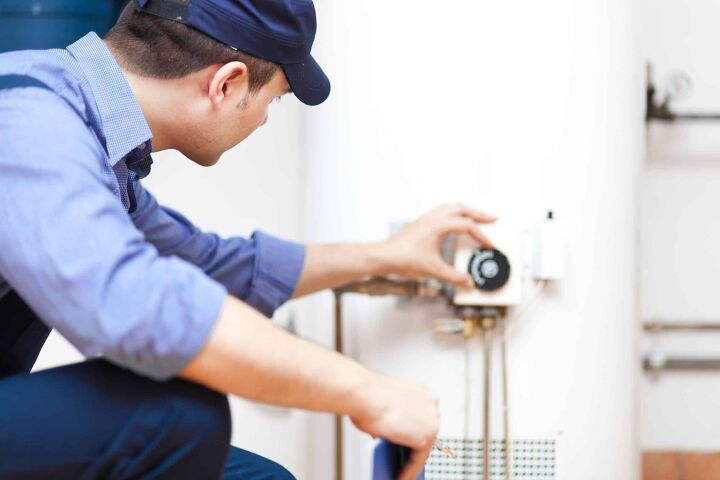How Do I Stop My Water Heater From Whistling?

All houses have a water heater. Otherwise, you would not have any hot water. Although there are several types of water heaters (gas, electric, and tankless), they all pretty much do the same thing. If you are not a plumber or electrician, hearing your water heater whistle can be very frightening. But it could be something simple to fix.
If your water heater is whistling, it is likely due to a faulty temperature relief (TPR) valve, cracked tank, bade anode rod, or leaking drain valve. If the water heat of your tank is too high, the TPR valve will automatically open to release some of the pressure, potentially causing a whistling sound.
No matter what kind of water heater you have, if it starts to whistle, that is not a good sign. It is best to turn it off and find out what is going on before turning it back on. Wait for the water heater to cool off before you start checking it out though.
Do You Need Water Heater Repair Services?
Get free, zero-commitment quotes from pro contractors near you.

Checking Your Connections
After your water heater cools off, check to make sure all of the connections are tight. Sometimes a hose at the water inlet or outlet comes loose, and the whistling could be air or steam escaping through the leak. Look for corrosion or rust as well. If you find anything loose, tighten it and if you see rust or corrosion, clean it before tightening it up.
Take a Look at Your TPR Valve
The TPR valve is typically on top of your water heater and it is made to relieve the pressure from the tank. If the pressure builds up too much, it could lead to an explosion. The TPR valve will sense the pressure in the tank and automatically open up to relieve the pressure. This can often be the cause of the whistling and it is normal. It may just be that your temperature setting is too high.
If your setting is over 120 degrees, set it to 120 and see if the whistling stops. However, it is not normal if your TPR continues to whistle and does not stop or if it stops and then starts back up again right away. That could be a sign of a pressure problem and you will need to call in a professional to check it out. Other reasons that your TPR valve is constantly whistling include:
- Water is entering too fast
- There is too much sediment at the bottom of the tank
- The thermostat is faulty
Your Tank is Cracked
If you have an old water heater that is whistling and you have checked all the other issues, the tank probably has a crack in it. The corrosion and rust can weaken the walls of the tank and cause a leak or crack in the tank. You will need a professional to fix this problem since you probably will need a new tank.
A Leaky Drain Valve May Be the Problem
Every water heater tank has a drain valve at the bottom. This is for you to drain or flush your tank regularly. If this valve is not closed all the way, it could be causing the whistling noise. Or if it has a leak in it, this may also cause a whistling. If you notice water leaking out onto the floor after tightening up the drain valve, you should get it fixed or replaced.
Important Tip: You should flush your water heater tank once a year to prevent sediment from building up.
How to Flush Your Water Heater
It is not difficult to flush your water heater. All you are doing is draining the tank to remove dirt and sediment. To do this, all you will need is a garden hose and a bucket. Then just follow these easy steps:
Step One: Making Sure the Water Heater is Turned Off
Turn the hot water heater off. If your water heater is gas, be sure to turn off the gas line to the tank as well. Turn the cold water to the tank off too.
Step Two: Turning on the Hot Water
Turn on the hot water full blast in a tub or sink. Make sure it is not a sink that will overflow since you will be dealing with the water heater and won’t be near the sink.
Step Three: Hooking Things Up
Go ahead and open the TPR valve. Then tighten your garden hose to the drain spigot on your water heater tank. Turn the drainage spout on so the water starts flowing.
Step Four: Checking the Water
As you let the water flow into the bucket, keep watching it until the water runs clear. If the bucket gets full shut the drain spigot off and dump the water in the sink or outside. Turn the spigot back on and continue draining the tank until the water is clear.
Step Five: Turning the Water On
Turn the cold water to the water heater back on and let it run for about a half-hour. Then you can turn the cold water back off for the time being.
Step Six: Filling Up the Tank
Turn the drainage spigot off and remove your garden hose. Go ahead and close the TPR valve again. Turn the cold water on again and let the tank fill back up.
Step Seven: Finishing Up
Once the hot water tank is full, you can open the TPR valve back up to let out the air. Then turn the gas back on and relight the pilot light. Turn the water heater back on and turn off the water you left running in your sink.
Do You Need Water Heater Repair Services?
Get free, zero-commitment quotes from pro contractors near you.

Related Questions
What Are Some Other Symptoms of a Faulty Water Heater?
Some of the typical signs of a water heater that may be going out include:
- You do not have hot water
- The tank is leaking
- Popping or other strange noises coming from the tank
- The water in your taps is gritty or brown
- Your water has a funny smell
- You can smell gas or something else weird near the tank
Whether you have a brand-new water heater or one that came with the house 20 years ago, you should have it checked regularly for problems. Having a pro come and check it out once a year is a good idea. This is especially important if you have a gas water heater because it could cause a carbon monoxide leak.
What Are the Signs of Carbon Monoxide Poisoning?Even if your hot water heater is whistling or the pilot light goes out, it is probably not leaking any carbon monoxide. However, there are some things that can cause carbon monoxide in the air from the water heater. Especially if the tank is in a closet or other enclosed space where it does not get enough air. These are the symptoms to look for:
- Chest pain
- Confusion
- Dizziness
- Nausea
- Severe headaches
- Vomiting
- Weakness
If you or anyone in the home is having any of these symptoms, you should turn off the water heater, open some windows, and go outside. Call the gas company and tell them you may have a carbon monoxide leak. You can also call 911 to care for anyone with symptoms. If you do not have a carbon monoxide detector in your home, you should get one. Especially if you have gas appliances. Anyone with a gas water heater or home heating system should have a carbon monoxide detector to warn you if there is a leak.

I am a DIYer who loves writing about anything home-related. When I am not writing, you can find me studying for my PhD in Psychology, photographing nature, and swimming at the lake with my grandkids.
More by Patricia Oelze



























